15. A long, straight wire carries a current i. A particle having a positive charge q and mass m kept at a distance
x0 from the wire is projected towards it with a speed v. Find the minimum
separation between the wire and the particle
Sol. 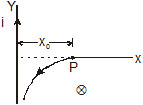
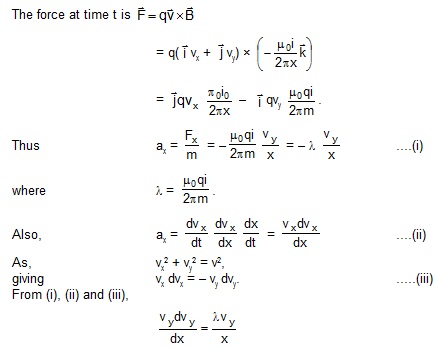
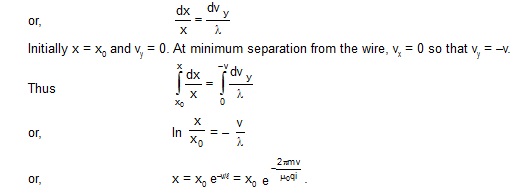
Exercise

Ans. 5.0 m T
4. A transmission wire carries a current of 100 A. What would be the magnetic field B at a point
on the road if the wire is 8 m above the road ?
5. A long, straight wire carrying a current of 1.0 A is placed horizontally in a uniform magnetic field
B = 1.0 × 10–5 T pointing vertically upward (figure). Find the magnitude of the resutlant magnetic
field at the points P and Q, both situated at a distance of 2.0 cm from the wire in the same horizontal plane.
6. A long, straight wire of radius r carries a current i and is placed horizontally in a uniform magnetic field
B pointing vertically upward. The current is uniformly distributed over its cross-section. (a) At what points
will the resultant magnetic field have maximum magnitude? What will be that maximum magnitude?
(b) What [5 min.]

7. A long vertical wire carying a current of 30 A is placed in an external, uniform magnetic field of 4.0 × 10–4
T parallel to the current. Find the magnnitude of the resultant magnetic field at a point 2.0 cm away from the wire.
8. A long, vertical wire carrying a current of 10 A in the upward direction is placed in a region where a horizontal
magnetic field of magnitude 2.0 × 10–3 T exists from south to north. Find the point where the resultant magnetic field is zero.
Ans. 5 × 10–4 T
9. Figure shows two parallel wires separated by a distance of 4.0 cm and carrying equal currents of 10 A along
opposite directions. Find the magnitude of the magnetic field B at the point A1, A2, A2 and A4.
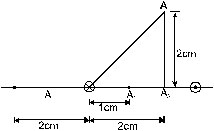
Ans. 5 × 10–4 T
10. Two parallel wires carry equal currents of 10 A along the same direction and are separated by a distance of
2.0 cm. Find the magnetic field at a point which is 2.0 cm away from each of these wires.
Ans. (a) 0.67 × 10–4 T (b) 2.7 × 10–4 T (c) 2.0 × 10–4 T (d) 1.0 × 1.0–4 T
11. Two long, straight wires, each carrying a current of 5 A, are placed along the X-axis and Y-axis respectively.
The currents point along the positive direction of the axes. Find the magnetic fields at the points
(a) (1 m , 1m), (b) (–1 m, 1m), (c) (–1 m, –1m) and (d) (1m, – 1m).
![]()
12. Four long straight wires, each carrying a current of 5.0 A, are placed in a placed in a plane as shown in figure.
The points of intersection from square of side 5.0 cm.
(a) Find the magnetic field at the centre P of the square.
(b) Q1, Q2, Q3 and Q4 are points situated on the diagonals of the square and at a distance from P that is equal
to the length of the diagonal of the square. Find the magnetic fields at these points.

![]()
13. Figures shows a long wire bent at the middle to form a right angle. Show that the magnitudes of the
magnetic fields at the points P, Q, R and S are equal and find this magnitude.
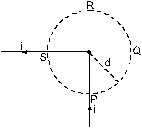
![]()
14. Consider a straight piece of length x of a wire carrying a current i. Let P be a point on the perpendicular bisector
of the piece, situated at a distance d from its middle point. Show that for d > > x, the magnetic field at P varies as
1/d2 whereas for d < < x, it varies as 1/d.
15. Consider a 10 cm long piece of a wire which carries a current of 10 A. Find the magnitude of the magnetic field
due to the piece at a point which makes an equilateral triangle with the ends of the piece.
![]()
16. A long, straight wire carries a current i. Let B1 be the magnetic field at a poit P at a distance d from the wire.
Consider a section of length l of this wire such that the point P lies on a perpendicular bisector of the section.
Let B2 be the magnetic field at this point due to this section only. Find the value of d/l so that B2 differs from B1 by 1%.
17. Figure shows a square loop ABCD with edge-length . The resistance of the wire ABC is r and that of ADC is 2r.
Find the magnetic field B at the centre of the loop assuming uniform wires.


18. Figure shows a square loop of edge a made of a uniform wire. A current i enters the loop at the point A and leaves
it at the point C. Find the magnetic field at the point P which is on the perpendicular bisector of AB at a distance a/4 from it.


19. Consider the situation described in the previous problem. Suppose the current i enters the loop at the point A and
leaves it at the point B. Find the magnetic field at the centre of the loop.
Ans. zero
20. The wire ABC shown in figure forms an equilateral triangle. Find the magnetic field B at the centre O of the
triangle assuming the wire to be uniform.
21. A wire of length l isbent in the form of an equilateral triangle and carries an electric current i.
(a) Find the magnetic field B at the centre. (b) If the wire is bent in the form of a square, what
would be the value of B at the centre ?

23. Find the magnetic field B at the centre of a rectangular loop of length l and width b, carrying a current i.
![]()
24. A regular polygon of n sides is formed by bending a wire of total length 2pier which carries a current i.
(a) Find the magnetic field B at the centre of the polygon. (b) By letting n ® ¥, deduce the expression
for the magnetic field at the centre of a circular current.

25. Each of the batteries shown in figuer has an emf equal to 5 V. Show that the magnetic field B at the
point P is zero for any set of values of the resistances.
26. A straight, long wire carries a current of 20 A. Another wire carrying equal current is placed parallel to it.
If the force acting on a length of 10 cm of the second wire is 2.0 × 10–5 N, what is the separation between them ?
Ans. 40 cm
27. Three coplanar parallel wires each carrying a current of 10 A along the same direction, are placed with a separation
5.0 cm between the consecutive ones. Find the magnitude of the magnetic force per unit length acting on the wires.
Ans. zero on the middle wire and 6.0 × 10–4 N towards the middle wire on each of the rest two
28. Two parallel wires separated by a distance of 10 cm carry currents of 10 A and 40 A along the same direction.
Where should a third current be placed so that it experiences no magnetic force?
Ans. 2 cm from the 10 A current and 8 cm from the other
29. Figure shows a part of an electric circuit. The wires AB, CD and EF are long and have identical resistances.
The separation between the neighbouring wires si 1.0 cm. The wires AE and BF have negligible resistance
and the ammeter reads 30 A. Calculate the magnetic force per unit length of AB and CD.

Ans. 3 × 10–3 N/m, downward zero
30. A long, straight wire is fixed horizontally and carries a current of 50.0 A, A second wire having linear mass
density 1.0 × 10–4 kg/m is placed parallel to and directly above this wire at a separation of 5.0 mm. What
current should this second wire carry such that the magnetic repulsion can balance its weight ?
31. A square loop PQRS carrying a current of 6.0 A is placed near a long wire carrying 10 A as shown in figure
(a) Show that the magnetic force acting on the part PQ is equal and opposite to that on the part RS.
(b) Find the magnetic force on the square loop.
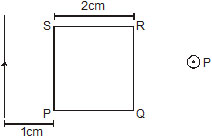
Ans. (b) 1.6 × 10–6 N towards right.
32. A circular loop of one turn carries a current of 5.00 A. If the magnetic field B at the centre is
0.200 mT, find the radius of the loop.
33. A current carrying circular coil of 100 turns and rdius 5.0 cm produces a magnetic field of
6.0 × 10–5 T at its centre. Find the value ofthe current.
34. An electron makes 3 × 105 revolutions per second in a circle of radius 0.5 angstrom.
Find the magnetic field B at the centre of the circle.
35. A conducting circular loop of radius a is connected to two long, straight wires.
The straight wires carry a current i as shown in figure. Find the magnetic field B at the centre of the loop.

36. Two circular coils of radii 5.0 cm and 10 cm carry equal currents of 2.0 A. The coils have 50 and 100 turns
respectively and are placed in such a way that their planes as well as the centre coincide. Find the magnitude
of the magnetic field B at the common centre of the currents in the coils are (a) in the same sense (b) in the opposite sense.
Ans. zero
37. If the outer coil of the previous problem is rotated through 90º about a diameter, what would be the magnitude
of the magnetic field B at the centre?
Ans. 1.8 mT
38. A circular loop of radius 20 cm carries a current of 10 A. An electron crosses the plane of the loop with a speed of
2.0 × 106 m/s. The direction of motion makes an angle of 30° with the axis of the circle and passes through its centre.
Find the magnitude of the magnetic force on the electron at the instant it crosses the plane.
39. A circular loop of radius R carries a current I. Another circular loop of radius r (<< R ) carries a current i and
is placed at the centre o the larger loop. The planes of the two circles are at right angle to each other.
find the torque acting on the smaller loop.
40. A circular loop of radius r carrying a current i is helf at the centre of another circular loop of radius R(>>r) carrying a
current I The plane of the smaller loop makes an angle of 30º with that of the larger loop. If the smaller loop is held
fixed in this position by applying a single force at a point on its periphery, what would be the minimum magnitude of this force?
![]()
41. Find the magnetic field B due to a semicircular wire of radius 10.0 cm carrying a current of 5.0 A at its centre of curvature.
42. A piece of wire carryin a current of 6.00 A is bent in the form of a circular arc of radius 10.0 cm, and it subtends an angle
of 120° at the centre. Find the magnetic field B due to this piece of wire at the centre.
43. A circular loop of radius r carries a current i. How should a long, straightr wire carrying a current 4i be placed in the
plane of the circle so that the magnetic field at the centre becomes zero?

45. A circular loop of radius 4.0 cm is placed in a horizontal plane and carries an electric current of 5.0 A in the clockwise
direction as seen from above. find the magnetic field (a) at a point 3.0 cm above the centre of the loop
(b) at a point 3.0 cm below the centre of the loop.
Ans. : 4.0 × 10–5 T, downwards in both the cases
46. A charge of 3.14 × 10–6 C is distributed uniformly over a circular ring of radius 20.0 cm. The ring rotates about its
axis with an angular velocity of 60.0 rad/s. Find the ratio of the electric field to magnetic field at a point on the axis
at a distance of 5.00 cm from the centre.
Ans. 1.88 × 10–15 m/s
47. A thin but long, hollow, cylindrical tube of radius r carries a current i along its length. Find the magnitude of the
magnetic field at a distance r/2 from the surface (a) inside the tube (b) outside the tube.

48. A long, cylindrical tube of inner and outer radii a and b carries a current i distributed uniformly over its cross-section.
Find the magnitude of the magnetic field at a point (a) Just inside the tube (b) just outside the tube.
49. A long, cylindrical wire of radius b carries a current i distributed uniformly over its cross-section. Find the magnitude
of the magnetic field at a point inside the wire at a distance a from the axis.
50. A solid wire of radius 10 cm carries a current of 5.0 A distributed uniformly over its cross-section.
Find the magnetic field B at a point at a distance (a) 2 cm (b) 10 cm and (c) 20 cm away from the axis.
Sketch a graph of B versus x for 0 < x < 20 cm.
51. Some time we show an idealised magnetic field which is uniform in a given region and falls to zero abruptly.
One such field is represented in figure. Using Ampere's law over the path PQRS, show that such a field is not possible.
52. Two large metal sheets carry surface currents as shown in figure. The current through a strip of width dl is
Kdl where K is a constant. Find the magnetic field at the point P, Q and R.
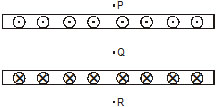
Ans. 0, m0 K towards right in the figure, 0
53. Consider the situatio of the previous problem. A particle having charge q and mass m is projected from the point Q
in a direction going into the plane of the diagram. It is found to describe a circle of radius r between the two plates.
Find the speed of the charged particle.
54. The magnetic field B inside a long solenoid, carrying a current of 5.00 A, is 3.14 × 10–2 T. Find the number of
turns pwr unit length of the solenoid.
Ans. 5000 turns/m
55. A long solenoid is fabricated by closely winding a wire of radius 0.5 mm over a cylindrical nonmangetic frame
so that the successive turns nearly touch each other. What would be the magnetic field B at the centre of the
solenoid if it carries a current of 5 A?
Ans. 2pie × 10–3 T
56 A copper wire having resistance 0.01 ohm in each metre is used to wind a 400 turn solenoid of radius 1.0 cm
and length 20 cm. Find the emf of a battery which when connected across the solenoid will cause a magnetic
field of 1.0 × 10–2 T near the centre of the solenoid.
Ans. 2pie × 10–3 T
57. A tightly wound solenoid of radius a and length l has n turens per unit length. It carries an electric current i.
Consider a length dx of the solenoid at a distance x from one end. This contians n dx turns and may be
approximated as a circular current in dx. (a) Write the magnetic field at the centre of the solenoid due to
this circular current. Integrate this expression under proper limits to find the magnetic field at the centre of the
 .
.
Ans. (a)
58. A tightly wound, long solenoid carries a current of 2.00 A. An electron is found to execute a uniform circular
motion inside the solenoid with a frequency of 1.00 × 108 rev/s. Find the number of turns per metre in the solenoid.
Ans. : 1240
59. A tightly-would, long solenoid has n turns per unit length, a radius r and carries a current i. A particle having
charge q and mass m is projected from a point on the axis in a direction perpendicular to the axis. What can
be the maximum speed for which the particle does not strike the solenoid?

60. A tightly-wound, long solenoid is kept with its axis parallel to a large metal sheet carrying a surface current.
The surface current through a width dl of the sheet is Kdl and the number of turns per unit length of the solenoid.
(b) If the solenoid is rotated to make its axis perpendicular to the metal sheet, what would be the magnitude of
the magnetic field near its centre?
![]()
61. A capacitor of capacitance 100 mF is connected to a battery of 20 volts for a long time and then disconnected from it.
It is now connected across the capacitor drops to 90% of its malximum value in 2.0 seconds. Estimate the average
magnetic field produced at the centre of the solenoid during this period.
Ans. 16pie × 10–8 T.